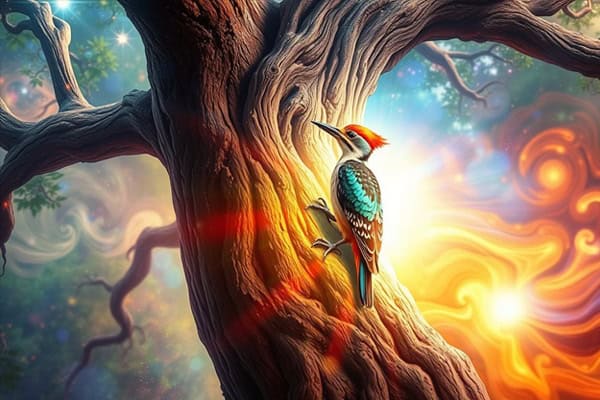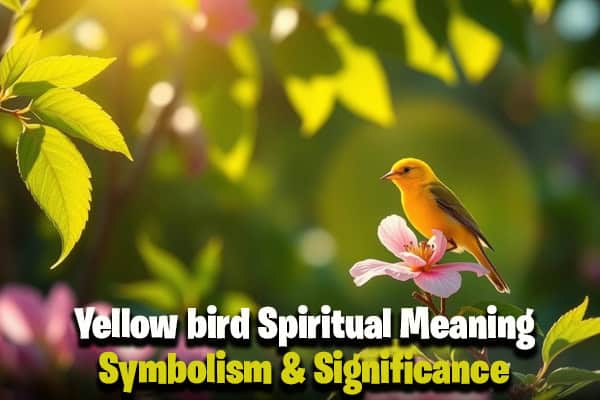What Do The Numbers On Binoculars Mean: A Quick Guide
What Do The Numbers On Binoculars Mean? They’re more than just random digits. They tell you about your binoculars’ power and how well they’ll perform. If you love the outdoors, knowing what these numbers mean can help you pick the best binoculars for your adventures.
Let’s dive into what these numbers mean and how they affect your binoculars. This guide will help you understand the specs and find the perfect pair for your next outing.
~What Do The Numbers On Binocular Mean~
When you look at binoculars, you’ll see numbers like “8×42” or “10×50”. These numbers tell you a lot about the binoculars. The first number shows how much closer things will look. The second number is the size of the lenses in millimeters, which affects how bright the image is.
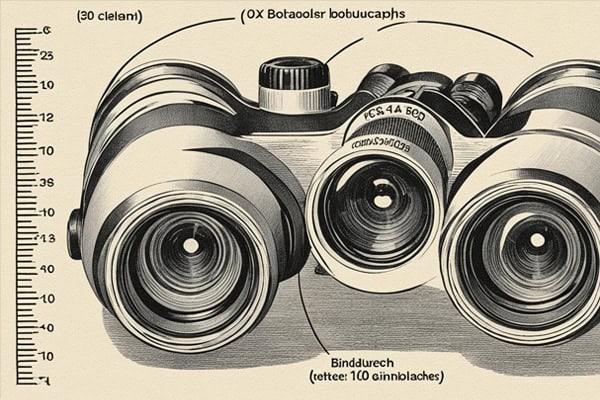
It’s important to understand these numbers when picking the right binoculars. The magnification, from 6x to 12x, tells you how close you can zoom in. A higher magnification is great for wildlife or hunting but can make the image shaky. The size of the objective lenses is key for seeing in the dark.
Magnification and Objective Lens Diameter
The first number shows the magnification, or how much closer things will look. For instance, 8x binoculars make things appear 8 times closer than with your bare eyes. The second number is the size of the objective lens in millimeters. It affects how much light the binoculars can take in and how bright the image will be.
Fixed and Variable Power
Binoculars can either have fixed or variable magnification. Fixed power binoculars have one zoom setting. Variable power binoculars let you change the zoom from a lower to a higher setting. Variable power binoculars are more flexible but can be heavier and may lose some image quality at high zoom.
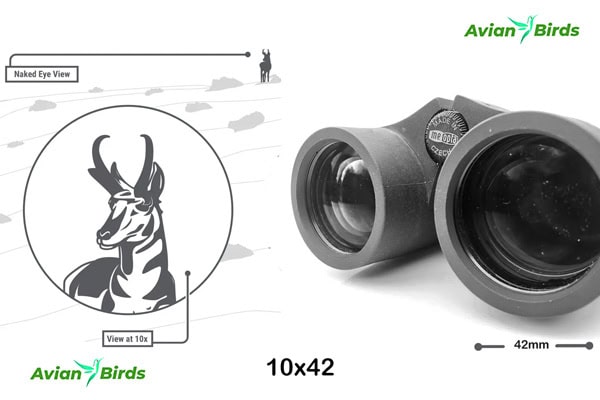
Experts usually suggest 8x to 10x magnification for the best balance of power and stability.
Objective Lens Diameter
The size of the objective lens in binoculars affects how bright and clear your view is. A bigger lens, like the 56mm in a 15×56 model, lets in more light than a 42mm lens in a 10×42 model. This means you get brighter and clearer images, especially in dim light.
But, bigger lenses make binoculars heavier and pricier. When picking a lens size, think about how you’ll use your binoculars and what you can carry. For most outdoor activities, a 42mm objective lens is a great choice. It balances binocular brightness with being easy to carry.
If you want top-notch binocular image quality and need clear views in tough light, consider a bigger lens. Options like 50mm or 56mm are good for dawn or dusk. But remember, bigger lenses mean bigger and heavier binoculars.
Field of View (FOV) and Angle of View (AOV)
When picking binoculars, think about the field of view (FOV) and angle of view (AOV). The FOV shows what you can see 1,000 yards away. The AOV measures the angle of that view. A bigger FOV or AOV helps you spot and track fast-moving targets like birds or wildlife. A smaller FOV or AOV is better for looking at small areas closely.
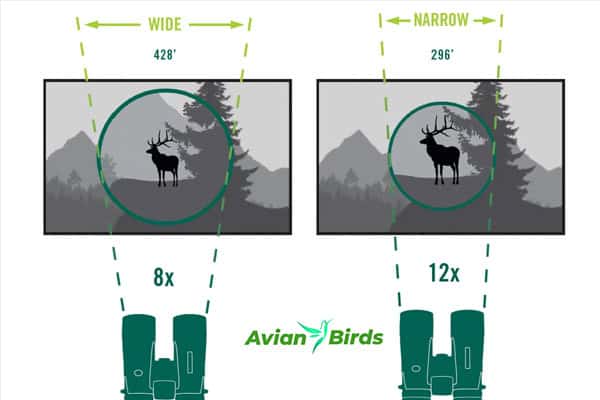
How FOV and AOV Impact Binocular Usage
Binoculars with higher magnification have a smaller FOV and AOV. For instance, an 8×42 binocular offers a wider view than a 12×50 binocular. The 8×42 is great for binocular field of view for hunting because it lets you quickly spot and track moving targets. The 12×50, with its narrower binocular angle of view, is better for detailed looks at small objects or distant scenes.
When picking binoculars, think about what you’ll be doing with them. A wider FOV and AOV are great for hunting, birdwatching, and other outdoor activities. They help you quickly find and follow moving subjects.
Knowing what the numbers mean helps you choose the best binocular specifications for what you want to do. Whether it’s birdwatching, hunting, or just enjoying the view, this knowledge is crucial. It ensures you pick the right binoculars for top performance.
Choosing the Right Binocular Numbers
Choosing the right numbers of binoculars for hunting is key. You need to think about the magnification and objective lens size based on your hunting style. For hunting in the woods, 8x to 10x magnification is best because it’s easier to keep steady without a tripod.
In open areas, 10x to 15x magnification is better for seeing far away. This helps you spot the game from a distance.
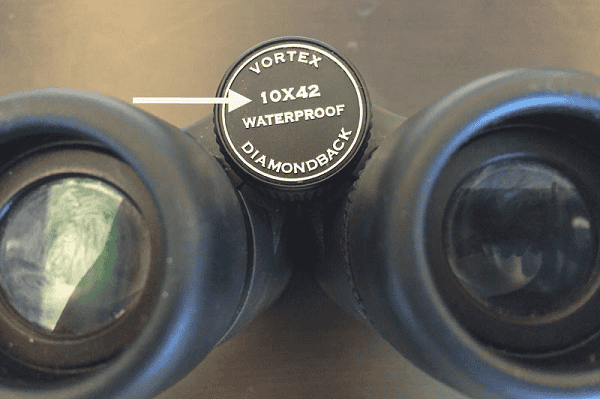
Magnification for Different Hunting Scenarios
The magnification affects your hunting experience. Lower powers, like 8x or 10x, are easier to use and give a wider view. They’re great for hunting in dense areas.
Higher powers, such as 12x or 15x, are better for seeing far away in open areas. They let you spot the game from a distance.
Objective Lens Size and Low-Light Performance
The size of the objective lens is important, especially in low light. Bigger lenses, like 50mm or 56mm, let in more light, making images brighter. But, they also make the binoculars heavier.
For hunters who need to move fast, smaller lenses like 8×32 or 10×32 might be better. But, if you’re in a stationary setup, like a truck blind, larger lenses like 12×50 or 15×56 are better for low light.
1. Physical Size
Choosing binoculars means looking at their size, weight, eye relief, and close focus. Compact, lightweight binoculars are great for mobile hunters. They are easy to carry and move around with. On the other hand, bigger binoculars offer more brightness and stability for long-range viewing.
2. Eye Relief
The eye relief is key for people who wear glasses. It’s the distance from the eyepiece to your eye. Look for binoculars with at least 15.5mm eye relief for a clear view, even with glasses on.
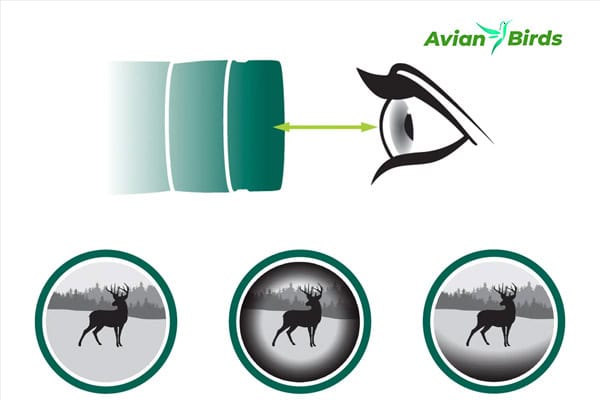
3. Close Focus
The close focus distance is also important. It’s the nearest object you can see clearly. Most binoculars focus on objects about 5 feet away. This is perfect for birdwatching and nature-watching. But hunters might not need this feature as much.
When picking binoculars, consider their size, weight, eye relief, and close focus. This will help you find the best pair for your activities, whether you’re hunting, birdwatching, or just enjoying the outdoors.
Wrapping Up…
Understanding the numbers on binoculars helps you pick the right pair for your outdoor fun. Whether you’re into hunting, shooting, or just enjoying nature, knowing about magnification and other specs is key. This ensures you get a pair that fits your needs perfectly.
Looking for the right binocular buying guide can change your viewing game. By thinking about what you need, you can pick the best pair for you. With the right info, you’ll find a balance of features that improve your outdoor adventures.
At first, the numbers on binoculars might look confusing. But with some research and understanding, you’ll easily pick the best pair for your activities. Don’t hesitate to try different models until you find the one that suits you best. The perfect binocular is out there, waiting for you to discover it.




